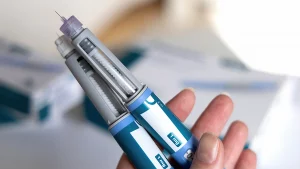ALTHOUGH Apple neglected to integrate menstrual cycle data into their new Health App, there are a lot of independent fertility tracking apps out there to choose from — for both Apple and Android phones. Be careful, though, as only a few have the ability to truly aid you in achieving or avoiding pregnancy. Kindara is one of those and husband-and-wife founders Will Sacks and Kati Bicknell have set their sights on making Fertility Awareness more accessible, more accurate, and more modern. Fertility Awareness is the practice of tracking your fertility signs – basal body temperature and cervical fluid consistency, to name the two main elements – in order to understand when you are fertile and not fertile, as well as grasp overall hormonal health. This week they launch Wink, a thermometer to track your daily basal body temperature (BBT) that synchs automatically with Kindara and holds a whole host of other neat design features. It is set to banish any thoughts of Fertility Awareness being old-fashioned, or outdated or unscientific. Will Sacks gave Lady Clever the run-down:
What is BBT exactly and why does it matter for women?
BBT stands for “basal body temperature” and is the temperature of our bodies when at absolute rest — usually measured orally when first waking up in the morning. It’s a very useful vital sign and especially so for women. This is because basal temperature is affected by the progesterone level in a woman’s body. For most women, BBT is low during the pre-ovulatory part of her cycle, and shows a marked shift to a higher range after ovulation. This is because progesterone is released after ovulation and causes BBT to increase, so basal temperature gives insight into if and when ovulation is happening, as well as giving us information about reproductive health in general, including thyroid issues.
What is the Fertility Awareness method for avoiding pregnancy? Is there evidence to show that it works?
Fertility Awareness is a method of measuring fertility signs daily (usually basal temperature and cervical data) and applying 4 simple rules to this data to understand if a woman is fertile (able to conceive) or infertile (not able to conceive) each day. It’s based on the fact that women are only fertile for a small portion of their cycle, and so couples practicing fertility awareness are able to know when fertility is present and use a barrier method or abstain during these days, and have unprotected sex without fear of pregnancy on other, infertile days. During infertile days no protection is needed because there is essentially no chance of conception on those days.
Typically in an average 28-day cycle, a woman will have 7-10 days where protection is needed, and 18-21 days where no protection is needed. It’s also a great method for women with irregular cycles because it relies on daily observations and not calculations of past cycle history like the now-discredited Rhythm Method.
There’s tons of evidence showing that Fertility Awareness is as effective as the birth control pill when the rules are followed. The BBC published the results of a large study done in Germany that showed the method to be 99.4% effective.
So Fertility Awareness is essentially a hormone-free, side-effect-free, extremely effective method of birth control that most people have never heard of.
There are a lot of apps out there right now making claims regarding helping women to avoid pregnancy. How is Kindara different?
Most apps that make claims about avoiding pregnancy are based on the Rhythm Method. It is a massive misconception that the Rhythm Method is synonymous with the Fertility Awareness Method. As I said, Fertility Awareness has been shown to be over 99% effective, while the Rhythm Method is 70% effective at best.
Additionally, Kindara is based on a rigorous implementation of the Fertility Awareness Method. We allow women to apply the rules of the method and make their own choices about when they are fertile or not. This puts the information and the power to choose in the hands of each individual woman.
And lastly, we have a really powerful community feature that allows women to share their charts with others for advice, guidance and support. We also have a practitioner portal that allows women to share their charts with any practitioner they may be working with.
What were you looking to improve on with Wink? Was it in response to some of the barriers women encounter when tracking their cycles?
I’m a strong believer in making things easy as a way to change behavior. Taking your temperature in the morning and then entering it into your phone later makes it a little bit harder to use Kindara and to use Fertility Awareness. Kati and I thought that women deserved a seamless experience to manage their reproductive health, and we thought if we created that experience, more women would be attracted to Kindara and fertility charting. We thought that something as important as avoiding or achieving pregnancy deserved sleek and modern technology to make it easier for women and couples to practice this method.
We put a ton of design effort into Wink, to ensure that it’s the most advanced fertility thermometer on the planet. Wink is very accurate, and yet it takes your temperature quickly. Wink vibrates instead of beeping so it won’t wake your partner up, and has a beautiful back-lit screen that is easy to see in a dimly-lit bedroom. And Wink syncs seamlessly with your phone using Bluetooth Low Energy. Unlike cheap $10 drugstore thermometers that are hard plastic and beep annoyingly, we wanted the entire experience of using Wink to be simple and enjoyable so women can feel appreciated while charting their cycles.
Why do you think Fertility Awareness is increasing in popularity?
I think the last century was about solving health problems with pills and synthetics, and this century is about solving health problems with software and data. The pill was an enormous boon for the previous generation. It set women free in so many ways, but it also came with side effects that a lot of women nowadays are finding unacceptable. Fertility Awareness is effective, low-cost, and side-effect-free so I think women and couples are finding it an attractive option.
I also happen to think that Fertility Awareness is a consciousness-raising tool — it helps women tune into and feel powerful and in control of their health, and it helps male partners better understand the feminine. As consciousness and mindfulness increase globally, using synthetic hormones to control fertility is becoming less acceptable, and Fertility Awareness, which is the practice of living in harmony with your cycle, is becoming more obvious.
One of the main criticisms of Fertility Awareness is that it takes too much time and effort to do properly. How does Wink help with this?
I think as our understanding of behavior change develops, we’re realizing the awesome power of habit. People who are in the habit of taking their temperature don’t think it’s hard, it’s just something they do in the morning. The same way brushing your teeth is something you do before you go to bed. It takes 30 days to develop a habit and Wink is aimed at making this period as painless as possible. Women can take their temperature in the morning and then forget it and it will be automatically synced with their phone.
How will Wink make Fertility Awareness even more accurate as a method?
Wink helps to remove the element of human error that exists in taking your temperature, remembering it, and correctly entering it into your phone. Because Wink syncs your temperature and the time it was taken automatically, women using Wink and Kindara will know their actual temperatures are being recorded accurately on their chart.
Wink is now available for pre-order and mailing will be available in Spring 2015. Get yours here.

















